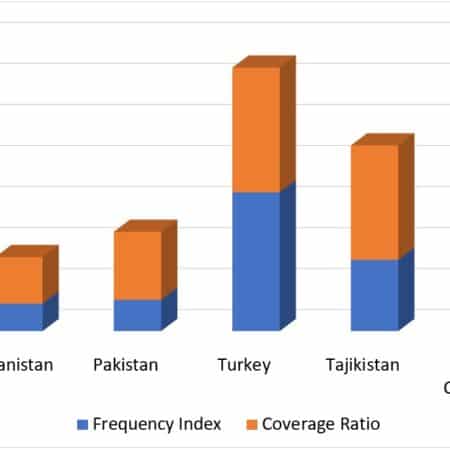
Pakistan Institute of Development Economics
- Home
Our Portals
MenuMenuMenuMenuMenuMenuMenu - ResearchMenuMenuMenuMenuMenuMenuMenu
- Discourse
- The PDR
- Our Researchers
- Academics
- Degree Verification
- Thesis Portal
- Our Portals

Barriers to Trade in the ECO Region: A Case of Non-Tariff Measures (NTMs)
Introduction
Non-tariff measures (NTMs) are policy measures other than tariffs that might impact international trade. Most NTMs serve legitimate policy goals. For example, by assuring limits on pesticides use ensures safe food to increase the welfare of the consumers. However, NTMs increase cost of trade as trading firms have to bear the compliance costs. Therefore, these measures act as impediments to the free flow of goods and services. A showcase of data for the ECO region on NTMs yields some interesting insights.
NTMs Incidence
Figures 1 and 2 provide the incidence of NTMs on imports and exports of the region. Figure 1 reports the frequency index and coverage ratio for imports. Frequency ratio is the percentage of products subject to one or more NTMs. On average, member countries apply NTMs for less than half of the about 5200 HS-6 digit products. This figure differs among the countries of the region. For example, Afghanistan and Pakistan use NTMs significantly less than Turkey and Tajikistan. Afghanistan, Pakistan, and Tajikistan apply NTMs far less than the world average (43.04%) while Turkey applies these measures far more (67.62%) than the world average.

Source: World Integrated Trade Solutions (WITS)
Coverage Ratio
The coverage ratio is the frequency ratio weighted by trade. We note that the coverage ratio is systematically higher than the frequency index. This implies that countries use NTMs on products that are more important in their import basket. The coverage ratio of imports shows that Turkey regulates its imports more than other members (61 percent) followed by Tajikistan, Pakistan, and Afghanistan. However, compared to the world average of 72 percent, ECO countries are more liberal.
Likewise, the export frequency index and the coverage ratio measure the regulatory requirements imposed by exporting countries on their exports. The coverage ratio of exports (Fig. 2) shows that Afghanistan regulates its exports more than other member countries. 70 percent of total export goods have at least one regulatory requirement to be fulfilled before their exports. Tajikistan regulates 24.16 percent of export goods and Turkey regulates 21 percent of total export goods. Pakistan has significantly liberalized its export regime and falls well below the world average of 27.31 percent. Only 18.65 percent of exported goods for Pakistan face incidence of NTMs.

Source: World Integrated Trade Solutions (WITS)
Regulatory Requirements
The frequency index (fig. 2) for exports shows that Turkey imposes regulatory requirements on 19.25 percent of export product lines (1000 HS-6 digit products). Whereas Afghanistan maintains regulatory requirements on 11.37 percent of export product lines (591 HS-6 digit products), Pakistan on 14 percent of export product lines (728 HS-6 digit products), and Tajikistan on 16.41 percent of export product lines (853 HS-6 digit products). It is clear from the above figure that the ECO average regulatory requirements for exports are lesser than the world average number of requirements for exports (22 percent). That is, on average, 792 products have to meet one or more regulatory requirements before their exports compared with the world average of 1137 products.
Figure 3 reveals that countries tend to protect their agriculture sector more than other sectors of the economy. The frequency index for the agri-food group is close to 100 while that of other sectors averaged around 35 percent.

Source: World Integrated Trade Solutions (WITS)
Concluding Comments
In sum, the following trends emerge from the above analysis. First, frequency indices of exports and imports are generally lower than their coverage ratios, which imply that countries regulate those products which matter most in their trade composition. Secondly, countries tend to regulate their imports more than their exports. Finally, the difference between the frequency indices and coverage ratios of exports and imports is higher for Afghanistan, which implies that Afghanistan regulates its exports more strategically than imports. Other member countries regulate their imports more strategically than exports. Afghanistan applies export measures only on 11.38 percent of products but those products account for 70 percent of its export value.
Download full PDF


